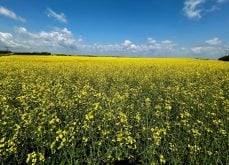EDMONTON — Clubroot continues to be a growing problem in the lucrative canola industry, said Stephen Strelkov, a University of Alberta pathologist and leader in clubroot research.
Clubroot was first identified in 12 canola fields near Edmonton on 2,000 acres in 2003. Since then it has been positively identified in 1,064 fields on more than 168,000 acres in 24 counties and within the city of Edmonton and three fields in Saskatchewan and Manitoba.
While originally believed to be associated with acidic soils, clubroot is mainly found in fields with a short canola rotation or no rotation, Strelkov told the International Clubroot Workshop.
Read Also

Louis Dreyfus posts higher volumes, lower profits in first half
Agricultural commodity merchant Louis Dreyfus Company recorded a rise in first-half sales, supported by higher volumes shipped, but weaker prices for most crops pushed down profits, it said on Friday.
“This has allowed the pathogen population to build up very quickly.”
In the nine-year period since it was first noticed, there has been an 89-fold increase. More awareness and increased surveillance accounts for some of the increase, but the spread of clubroot likely accounts for most, he said
Clubroot is generally found at the entrance of the fields and less often farther into the fields, suggesting chunks of soil containing clubroot spores were dropped at the entrance to the field.
“Machinery is playing a really important role.”
It’s likely the majority of clubroot is spread by machinery, but there are reports of clubroot spreading by tag on seed and tubers and through wind and water erosion.
Cleaning machinery is an important tool in reducing the spread of the disease, but using canola varieties resistant to clubroot represents one of the key clubroot management tools, he said.
“There is a huge difference between susceptible and resistant varieties,” but repeated use of resistance may erode the effectiveness of that resistance, he said.
“The resistance is holding up well and we don’t want to lose that management tool. Clubroot has become very well established in canola in central Alberta – it here to stay.”














